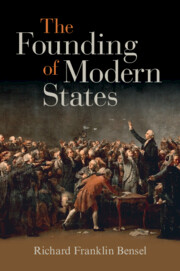Book contents
- The Founding of Modern States
- The Founding of Modern States
- Copyright page
- Dedication
- Contents
- Tables
- Boxes
- Preface
- 1 Introduction
- Part I The Founding of Democratic States
- Part II The Founding of Non-democratic States
- 5 The Dictatorship of the Proletariat
- 6 Blood and Soil
- 7 Islamic Theocracy
- 8 Conclusion
- Index
7 - Islamic Theocracy
The Iranian Revolution
from Part II - The Founding of Non-democratic States
Published online by Cambridge University Press: 27 October 2022
- The Founding of Modern States
- The Founding of Modern States
- Copyright page
- Dedication
- Contents
- Tables
- Boxes
- Preface
- 1 Introduction
- Part I The Founding of Democratic States
- Part II The Founding of Non-democratic States
- 5 The Dictatorship of the Proletariat
- 6 Blood and Soil
- 7 Islamic Theocracy
- 8 Conclusion
- Index
Summary
On January 7, 1978, Daryush Homayun, the Shah’s Information Minister, published an article in a semiofficial newspaper in which he described Ayatollah Ruhollah Khomeini as “an adventurer, without faith, and tied to the centers of colonialism … a man with a dubious past, tied to the more superficial and reactionary colonialists.” Writing under a pseudonym that in no way disguised the regime’s authorship, Homayun accused Khomeini of accepting money from the British in return for his public attacks on the Shah’s reform program. Rioting broke out the following day in the holy city of Qom after the regime’s security forces attempted to suppress protests by theological students. Some seventy people were killed in the next two days. Thus began the Iranian Revolution.1
- Type
- Chapter
- Information
- The Founding of Modern States , pp. 420 - 473Publisher: Cambridge University PressPrint publication year: 2022

